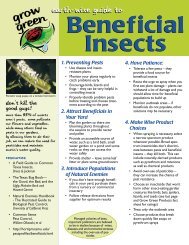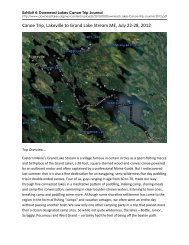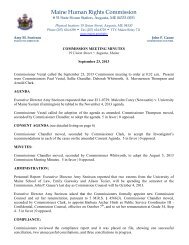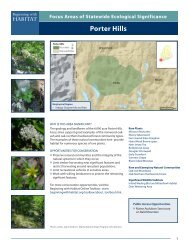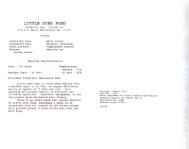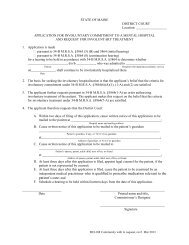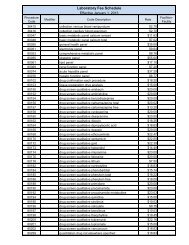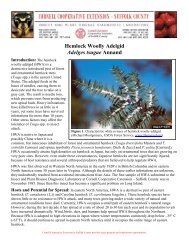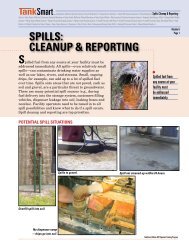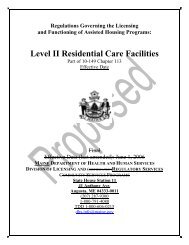TICK-BORNE DISEASES IN MAINE - Maine.gov
TICK-BORNE DISEASES IN MAINE - Maine.gov
TICK-BORNE DISEASES IN MAINE - Maine.gov
You also want an ePaper? Increase the reach of your titles
YUMPU automatically turns print PDFs into web optimized ePapers that Google loves.
BABESIOSIS<br />
treatment<br />
The regimens listed below are guidelines only and may need to be adjusted depending<br />
on a patient’s age, medical history, underlying health conditions, pregnancy<br />
status or allergies. Consult an infectious disease specialist for the most current<br />
treatment guidelines or for individual patient treatment decisions. †<br />
age category drug dosage maximum duration<br />
(days)<br />
Adults Atovaquone 750 mg orally<br />
every 12 hours<br />
plus<br />
Azithromycin<br />
OR<br />
Clindamycin<br />
plus<br />
Quinine<br />
500-1000 mg<br />
on day 1 and<br />
250 mg orally<br />
once per day<br />
thereafter<br />
300-600 mg<br />
IV every<br />
6 hours OR<br />
600 mg orally<br />
every 8 hours<br />
650 mg orally<br />
every 6-8 hours<br />
Children Atovaquone 20 mg/kg<br />
every 12 hours<br />
plus<br />
Azithromycin<br />
OR<br />
Clindamycin<br />
plus<br />
10 mg/kg once<br />
per day on<br />
day 1 and<br />
5 mg/kg<br />
once per day<br />
thereafter orally<br />
7-10 mg/kg IV<br />
or orally every<br />
6-8 hours<br />
N/A 7-10<br />
100 mg<br />
per dose<br />
7-10<br />
N/A 7-10<br />
100 mg<br />
per dose<br />
750 mg<br />
per dose<br />
500 mg<br />
per dose on<br />
day 1 and<br />
250 mg<br />
per dose<br />
thereafter<br />
600 mg<br />
per dose<br />
7-10<br />
7-10<br />
7-10<br />
7-10<br />
notes<br />
• For adult patients who are immunocompromised,<br />
higher doses of azithromycin,<br />
600-1000 mg per day, may be used.<br />
• The recommended treatment for patients<br />
with severe babesiosis, as indicated<br />
by high-grade parasitemia (=> 10%),<br />
significant hemolysis, or renal, hepatic or<br />
pulmonary compromise, is quinine and IV<br />
clindamycin, and the patient should be<br />
considered for partial or complete RBC<br />
exchange transfusion<br />
• Consider the possibility of coinfection with<br />
B. burgdorferi and/or A. phagocytophilum<br />
in patients with especially severe or<br />
persistent symptoms, despite appropriate<br />
antibabesial therapy.<br />
• Asymptomatic patients with a positive<br />
babesial smear and/or PCR results should<br />
have these studies repeated. Treatment<br />
should be considered if parasitemia persists<br />
for more than three months.<br />
REFERENCES<br />
American Academy of Pediatrics. Babesiosis In:<br />
Pickering LK, Baker CJ, Long SS, McMillan JA,<br />
eds. Red Book: 2009 Report of the Committee on<br />
Infectious Diseases. 28th ed. Elk Grove Village, IL:<br />
American Academy of Pediatrics; 2009: 226-227.<br />
Gelfand JA, Vannier E. Babesia Species. In:<br />
Mandell GL, Bennett JE, Dolin R, editors. Mandell,<br />
Douglas, and Bennett’s Principles and Practice<br />
of Infectious Diseases. 7th ed. Philadelphia, PA:<br />
Churchill Livingstone; 2010. p. 3539-3545.<br />
Homer MJ, et al. Babesiosis. Clinical Microbiology<br />
Reviews. 2000; 13(3): 451-469.<br />
Krause PJ. Babesiosis Diagnosis and Treatment.<br />
Vector-borne and Zoonotic Diseases.<br />
2003; 3(1): 45-51.<br />
Krause PJ, et al. Comparison of PCR with Blood<br />
Smear and Inoculation of Small Animals for Diagnosis<br />
of Babesia microti Parasitemia. Journal of<br />
Clinical Microbiology. 1996; 34(11): 2791-2794.<br />
Persing DH, et al. Detection of Babesia microti<br />
by Polymerase Chain Reaction. Journal of Clinical<br />
Microbiology. 1992: 30(8): 2097-2103.<br />
Ruebush TK, Juranek DD, Spielman A, Piesman J,<br />
Healy G. Epidemiology of Human Babesiosis<br />
on Nantucket Island. Am. J. Trop. Med. Hyg.<br />
1981; 30 (5): 937-941.<br />
Thompson C, Spielman A, Krause PJ. Coinfecting<br />
Deer-Associated Zoonoses: Lyme Disease,<br />
Babesiosis, and Ehrlichiosis. Clinical Infectious<br />
Diseases. 2001; 33: 676-685.<br />
†Wormser GP, Dattwyler RJ, Shapiro ED, et al. The<br />
Clinical Assessment, Treatment and Prevention of<br />
Lyme Disease, Human Granulocytic Anaplasmosis,<br />
and Babesiosis. Clinical Practice Guidelines by the<br />
Infectious Diseases Society of America. Clinical<br />
Infectious Diseases. 2006; 43: 1089-1134.<br />
Quinine<br />
8 mg/kg orally<br />
650 mg per<br />
7-10<br />
every 8 hours<br />
dose



